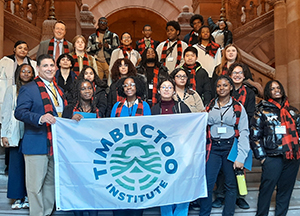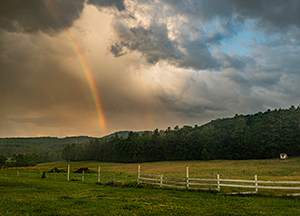
Celebrate National Invasive Species Awareness Week
Tuesday, February 28, 2017
By Lisa M. Genier - Adirondack Council Program Analyst
This week we celebrate National Invasive Species Awareness Week. We all need to learn about invasive species, what they can do to our lands and waters and how we can help prevent them from spreading.

Eurasion milfoil tangled in motor prop
Photo courtesy of APIPP
The Adirondack Council fights invasives species everyday by supporting better regulations, stewardship, education, and enforcement. We also understand that more money is needed to make these things happen, and we are pushing for that too.
The Council also works with landowners, local governments and other organizations, like the Nature Conservancy’s Adirondack Park Invasive Plant Program (APIPP), to better protect the environment of the Adirondack Park from invasives and to help enhance the economies of its communities.
But we need your help! We all need to do our part to protect our favorite places from invasive species by taking these simple steps. Spread the word...not the invasives!
- Clean drain & dry watercraft and gear after exiting a waterway.
- Don’t transport firewood. It might contain tree-killing pests – burn it where you buy it.
- Use only native plants in your garden.
- Report invasive species sightings. Click HERE.
Also celebrate Invasive Species Awareness Week by familiarizing yourself with invasives species. Some are below and you can find more HERE.
As you can see, some invasives don't look ominous. Some are even pretty. But beware...looks can be very deceiving.
 Emerald Ash Borer (Agrilus planipennis)Has a golden-green body with dark, metallic green wings and a purplish-red abdomen. Larvae feed on the bark tissue of native ash, effectively girdling the tree. Photo courtesy of APIPP |
 Eurasion Watermilfoil (Myriophyllum spicatum)Usually has four feathery leaves around the stem. Easily transported to and from waterbodies. Forms dense mats that degrade habitat and curtails recreational access. Photo courtesy of APIPP |
 Garlic Mustard (Alliaria petiolata)A biennial herb that can grow multiple stems up to 4 feet. In May, white flowers grow at the top of the stems. Releases chemicals harmful to soil fungus that is important to trees. Photo courtesy of APIPP |
 Giant Hogweed (Heracleum mantegazzianum)A biennial herb that grows to 8-14 feet. Best time to identify is when it blooms in June. Caution – Plant has sap that can cause severe skin irritation, blistering and scarring. Photo courtesy of NYSDEC |
 Japanese Knotweed (Fallopia japonica)A fast-growing, perennial with jointed, hollow stems and alternate, oval leathery leaves. White flowers bloom in August, and reddish stems are visible in winter. Photo courtesy of APIPP |
 Purple Loosestrife (Lythrum salicaria)A perennial that grows 3-7 feet. Easily identified by its magenta flowers from July to September. Invades wetlands and alters their ecological structure and function. Photo courtesy of APIPP |
 Spiny Waterflea (Bythotrephes cederstroemi)Tiny crustaceans less than 1/2″ with sharp, barbed tails. Predators of small zooplankton which is important food for young fishes. Reproduce rapidly and their eggs can lie dormant all winter Photo courtesy of APIPP |
 Zebra Mussels (Dreissena polymorpha)Tiny, freshwater mollusks with light & dark brown stripes. They displace native species and attach to surfaces. They remove particles from the water which affects the ecosystem. Photo courtesy of APIPP |
Please note: Some of this article originally ran on July 9, 2014.
Would you like to comment on what you've read or viewed? We'd love to hear from you. Please click to send us a message.
 Lisa M. Genier grew up in Mineville (Town of Moriah) in the Adirondacks and joined the Council in 1992 working as its Legislative Associate in the Albany office. During her tenure, she played a role in the creation of the Environmental Protection Fund, which has been used to fund land purchases and environmental programs in the Adirondack Park and around the state. She was also a member of the negotiating teams that worked on re-licensing agreements for several hydroelectric facilities in the Park, which preserved thousands of acres of land, expanded recreational opportunities, and protected other natural resources. Lisa now works part-time as Program Analyst writing action alerts, interacting with members, managing the Council’s website, and serving in a consultative role on legislative and other issues.
Lisa M. Genier grew up in Mineville (Town of Moriah) in the Adirondacks and joined the Council in 1992 working as its Legislative Associate in the Albany office. During her tenure, she played a role in the creation of the Environmental Protection Fund, which has been used to fund land purchases and environmental programs in the Adirondack Park and around the state. She was also a member of the negotiating teams that worked on re-licensing agreements for several hydroelectric facilities in the Park, which preserved thousands of acres of land, expanded recreational opportunities, and protected other natural resources. Lisa now works part-time as Program Analyst writing action alerts, interacting with members, managing the Council’s website, and serving in a consultative role on legislative and other issues.




